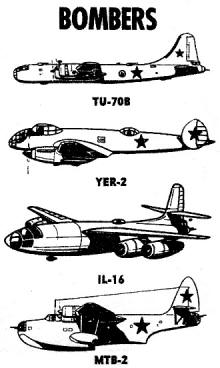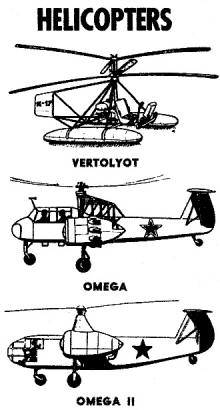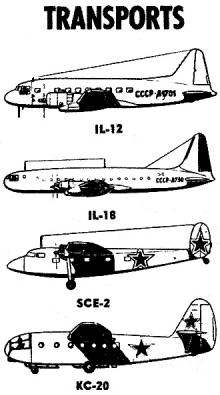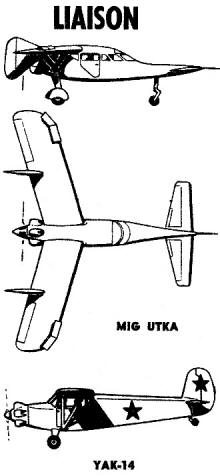|
Isn't it interesting how these
days you almost never hear Communists referred to as Communists? Up until the last
two decades or so, newspapers, magazines, television broadcasts, movies, et al,
regularly used the word to describe countries and leaders thereof such as Russia
and Soviet Union, China, Cuba, North Korea, and North Vietnam. I don't think it
is because we don't want to hurt anyone's feelings; rather, it is because the purveyors
of the media are openly simpatico with the precepts, but don't want to bear the
stigma of the title. Running governments and controlling the populace is so much
easier when pesky things like the Constitution are not in the way. In 1950 when
this "Commies in Profile" article appeared in Air Trails magazine, no pretenses
were made about who the bad guys were and calling the villain by name was popular.
Russia had been our ally in
World War II,
but only because we had a common enemy - the Axis powers. History records that the
only reason Stalin didn't side with Hitler was he did not agree with the post-war
power sharing scheme offered by the little dictator. Anyway, here is a collection
of known aircraft in the Russian air force in the time between WWII and Korea. The
similarity to many American, British, and German planes is obvious. The most interesting,
IMHO, is the MIG
Utka (duck) canard design, used for liaison purposes. It was one of the earlier
production designs.
Commies in Profile
 Some months back Air Trails presented evidence
that the Reds were stallin' when it came to aeronautical advancements. Here's an
updated report on the latest Russian warplanes that comes from behind the Communist
curtain. It proves that the Reds will be hard to beat in the air. Some months back Air Trails presented evidence
that the Reds were stallin' when it came to aeronautical advancements. Here's an
updated report on the latest Russian warplanes that comes from behind the Communist
curtain. It proves that the Reds will be hard to beat in the air.
Fighters
To underestimate the strength, brains and ability of a potential enemy is one
of the most serious mistakes a nation can make. Although a country may seem backward
to us by our own standards of everyday living, it does not follow that its military
might and know-how are on the same, less favorable level. The most striking example
of this paradox today is Communist Russia, and perhaps the most arresting phase
of that example is its air force.
Always having produced good firearms, artillery and tanks, the USSR is turning
out a first-class air arm which in quality approaches ours and in quantity probably
far exceeds it. Shrewd and unhampered by economic aspects. of government purchases,
Russia solved its engineering and technical handicaps by acquiring some of the best
scientific brains of Germany; moved a number of German plants into its interior,
and has in its possession many of the latest Nazi research and experimental aircraft,
jet engines and guided missiles. Add to all this the fact that Soviet industry has
remained on a war footing, and it is not hard to conclude that the Communists would
make a formidable adversary in the air.
Bombers
The Soviet planes shown on these pages confirm the strength of the Russian Air
Force. That the information on them is available also points to the likelihood the
Commies have bigger and better aircraft up their commodious red sleeve.
Helicopters
It might be pointed out that Russian airplanes are designated by the first two
letters of their designers' names and not by type as in the United States. Thus
the pre-fix YAK means the craft was designed by Alexander Yakovlev; LA, by Semyon
Lavochkin. If more than one person was responsible for the design, the designation
combines the initials of all, as in the case of the MIG, the designers of which
were Mikhoyan and Gurevitch.
Engine designers are also honored by having their names affixed to the name plates
of engines, except that the initials of the first name are added to those of the
given name. Thus, the ASH radial air-cooled engines are named after A. Shvetsov;
the 12-cylinder V-type liquid-cooled powerplants AM and VK after A. Mikulin and
V. Klimov. However, the Russians in some cases stick to the all-over designation,
of "M," (for motor) as exemplified by the engine designation of the small MIG Utka
liaison plane and the large four-engined transport TU-70.
 Fighters Fighters
YAK-9. This is a World War II single-place fighter of which
there are three variants, 9D, 9U and 9T. The D is a conventional high-altitude aircraft
while the T and U were modified to act as tank destroyers and low-altitude strafers.
The D was armed with a 20-mm cannon firing through the propeller hub and two synchronized
.50-cal. machine guns in the engine cowl. In the other two models the 20-mm cannon
was replaced by a 37-mm. The structure of the three models is the same, consisting
of a steel tube fuselage covered by plywood shell. The wing has an extruded aluminum
spar, wooden ribs and plywood skin. Control surfaces are fabric covered. The YAK-9
is also used by the Polish and North Korean air forces.
YAK-15. The first Russian service jet fighter, this is now relegated
to secondary duty of training jet pilots. Early news reports had this airplane appearing
on the Korean front. In any case, it is likely the Russians do not find its performance
adequate for their own service squadrons. It is claimed that the YAK-15 made its
debut in small numbers when the Soviet Forces entered Berlin in 1945. Contrary to
general practice, YAK-15 has two-wheel landing gear.
Wingspan 32 ft. 10 in. Engine Junkers Jumo type developing close to 4,000 lbs.
of thrust. Maximum speed, approximately 500 mph.
YAK-17. A new fighter, information on which is not available.
Generally resembles our Republic F-84. Tail-surface shape departs from usual Soviet
practice, especially as to the rudder, which in most cases has a well-rounded trailing
edge.
YAK-21. To call this airplane YAK is a typical Russian stunt,
for it is .nothing more than a redesigned Messerschmitt 163 or its later version
known as Junkers 248, the famous German rocket fighter. The designer Yakovlev did
add a horizontal tail to the original version. The YAK 21's are known to be in mass
production and fitted with adequate artillery to take care of any high-flying enemy
bombers which may invade Soviet territory. Duration 15 minutes.
MIG. This is a design by the combined forces of Mikhoyan and
Gurevitch who produced a number of successful fighters during the war. This particular
model is based on one of their latest efforts in piston-engined single-seaters to
which has been added a liquid-propellant rocket located in the rear section of the
fuselage. Whether this design was an experimental one to test rocket propulsion
or whether it is a standard service aircraft equipped with rocket boost for extra
thrust is a matter of speculation. By all outward appearance the plane is similar
to the MIG-5. The piston engine is a 14-cylinder, air-cooled radial ASH-82 rated
at 1675 hp.
MIG-9. This is a twin-jet heavy fighter with both engines located
on the underside of the fuselage, which has a single divided air intake in the nose.
The two power-plants are variously reported to be either the German BMW 03 of 3,300
lbs. thrust each, or the Russian Chelomeyov, a modified version of the BMW design,
but of greater thrust. Wingspan 40 ft. 6 in. Maximum speed approximately 600 mph.
LA-9. Single-place fighter, also a World War II plane, designed
by Semyon Lavochkin. The LA series of fighters were especially designed to combat
such German fighters as the FW-190, and were very fast and maneuverable. This model
and the improved LA-11 are still in active service with the Soviet fighter forces.
Probably the difference between the LA-9 and the LA-11 is in the "horses." The LA-9
is powered by an ASH-82 radial 14-cylinder engine of 1850 hp, while the LA-11 is
equipped with an ASH-90, a copy of our Wright 18-cylinder & Wright Duplex-Cyclone
rated at better than 2,000 hp. Armament consists of two 20-mm cannon in the wing
and two 50-cal. synchronized machine guns. Wingspan is 34 ft. 10 in. Maximum speed
400 mph or better.·
LA - Communist sources claim this to be the latest Russian fighter,
replacing the YAK-15. Has a sharply swept-back wing and T type tail surfaces. Slim
fuselage suggests use of axial flow jet engine with air intake in the fuselage nose.
Reported maximum speed over 650 mph.
LA - Research plane, similar to the LA above, its not identified,
though may also have come from the drawing board of Semyon Lavochkin. Has side air
intakes, swept-back wing and horizontal tail. There are rumors it is a supersonic
research monoplane.
LA-15. Single-place twin-jet fighter designed by Semyon Lavochkin
and undoubtedly influenced by the British Gloster Meteor.
 Bombers Bombers
TU-70B. Whether this is the true designation of this heavy four-engined
bomber is not known. Here the prefix TU means that the aircraft was designed by
Andrei Tupolev. Actually the bomber is a dead ringer for our B-29, several of which
made forced landings in Soviet territory after raids on Tokyo and have never been
returned to us. It is said that two were used for structural study and one for test
flying, after which the Russians turned out a large four-engined transport, the
TU-70, the outward appearance of which was very similar to the B-29.
On various occasions the TU-70B has been designated as the PE-8 by the press;
however, that would mean that its designer was Petlyakov and not Tupolev. The original
PE-8 was also a heavy bomber but powered by V-12 engines, and was built back in
1943. It made its appearance in Washington, during the war, having flown Molotov
over from Europe. In size and dimensions the TU-70B is identical with the B-29 and
is powered by four M-90 engines, copies of our Wright R-3,350, rated at 2,500 hp.
YER-2. Twin-engined medium bomber designed by Yermolayev. This
type first saw action during the Russo-Finish war. The craft is of all-metal construction
and has an inverted-gull wing in order to increase bomb bay space. Pilot's cockpit
is asymmetrically located on the left side of fuselage to permit better access to
the glassed-in bombardier compartment.
Wingspan 67 it. 6 in. Engine 12-cyl. VK-103 rated at 1050 hp. Top speed 265 mph.
A later model, YER-4 has the cockpit located centrally, is armed with .50-cal. guns
instead of .30 and has slightly more powerful engines, VK-105's of 1,100 hp. Maximum
speed is 280 mph.
IL-16. A four-jet bomber designed by Serge Ilyushin. Judging
from picture the only armament carried is twin machine guns in tail. Astrodome atop
fuselage suggests that this is a long-range aircraft.
MTB-2. The designation points to the fact that this flying-boat
patrol bomber is of World War II vintage as the letters are not initials of the
designer but are type designation. In this instance they mean "Navy Heavy Bomber."
Nevertheless. it is a fairly modern flying boat design, powered by four M-87 engines
of 1,100 hp each as well as a 1,200 hp V-12 powerplant in the fuselage driving a
large supercharger which supplies air boost to the four engines. The airplane was
used for anti-submarine patrol during the war and was later modified as a cargo
transport. Wingspan 121 ft.
 Helicopters Helicopters
Vertolyot, K·17. A small helicopter designed by N. I. Kamov.
(The name Vertolyot means vertical flight.) This particular craft is an experimental
prototype. The production article will have a regular streamlined fuselage and pilot
enclosure. Its application will be courier flights in and out of inaccessible areas.
Powered by a 17 hp modified Aubier-Dunne engine, similar to the one used in the
early Mignet Flying Flea plane.
Omega. First observed on the 1946 Air Force Day, the Omega helicopter is not
unlike our twin-rotor McDonnell XHJD-1. Engines are nine-cylinder radials of unknown
type. The designer of the aircraft is I. P. Bratuchin.
Omega II. Latest and streamlined version of Bratuchin's helicopter.
 Transports Transports
IL-12. A medium transport extensively used on the Russian main
airline Aeroflot as well as by some satellite countries. Carries 32 passengers as
a short-range airliner; for longer range the seating capacity is 27. Tricycle landing
.gear. Wingspan 104 ft. Engines two ASH-82's of 1,700 hp each. Maximum speed 250
mph at 8,000 ft.
IL-18. Large four-engined transport almost the size of our Stratocruiser.
Carrying capacity 66 passengers and a crew of five. Wingspan 131 ft. Engines four
ASH 88-112's rated at 1,700 hp. Maximum speed 300 mph. Range 1,850 miles.
SCE-2. A light transport which during the war was used as a
troop carrier and cargo craft for supplying Russian guerrillas behind the Nazi lines.
Designed by Alexei Scherbakov, a well-known glider designer. At present the SCE-2
serves as an inter-city cargo transport with Aeroflot. Span 72 ft. Engines two AM-11D
rated at 145 hp each.
KC-20. A large cargo and troop transport glider very similar
to our Waco CG-13. Designed by Kolesnikov and Cybin. These gliders are now used
for cargo carrying on regular airline routes. During last year's Air Force Day celebration,
twelve air trains each consisting of an IL-12 tow plane and two gliders were flown
over Moscow.
 Trainers Trainers
YAK-20. An all-metal military trainer, just recently placed
in production. No information as to dimensions, powerplant or performance available.
Probably on a par with our T-6.
Wingspan 32 ft. 10 in. Length 27 ft. 10 in. Gross wt. 7,100 lbs. Powered by a
V-12 liquid-cooled engine rated at 1,260 hp. Maximum speed 370 mph. Range 900 miles.
 Special Attack Craft Special Attack Craft
IL-10. An improved version of the famous Soviet anti-tank attack
plane IL-3 Stormovik. The Russians are firm believers in heavily armed and armored
low-level attack planes, and the Ilyushin machine is an excellent example of it.
The Stormoviks were the first planes to be armed with rockets. First, models, the
IL-2's, were single seaters, but later version, the IL-3, had a rear gunner as protection
from attack. The IL-10 has been considerably streamlined with flush landing-gear
retraction, the wings are more tapered and, the vertical surfaces increased in area.
 Span is 48 ft. Engine VK-I07 rated
at 1,800 hp. Maximum speed 280 mph. Armament consists of two 32-mm tank cannon and
two .30-cal. machine guns in the wing. Rear turret carries either one 20-mm cannon
or .50-cal. machine gun. In addition there are rocket launches underneath the wing. Span is 48 ft. Engine VK-I07 rated
at 1,800 hp. Maximum speed 280 mph. Armament consists of two 32-mm tank cannon and
two .30-cal. machine guns in the wing. Rear turret carries either one 20-mm cannon
or .50-cal. machine gun. In addition there are rocket launches underneath the wing.
PE-3. Multi-purpose medium bomber designed by Petlyakov. Saw
service during the latter part of the war as reconnaissance craft, dive bomber,
level bomber and fighter. Vane atop rear gun turret is supposed to correct for windage.
Span 56 ft. Engines two VK-105R's of 1,100 hp each. Maximum speed 266 mph.
Liaison
MIG "Utka." (Duck). A versatile and interesting canard
design for liaison, light cargo and instruction work. Can be transformed into a
snow-sled by installing skis and removing wings. Plane was designed by Mikhoyan
and Gurevitch.
Wingspan 32 ft. 8 in. Engine 110 hp M-11. Maximum speed 120 mph. Accommodations,
pilot and two passengers.
YAK-14. Liaison and sport plane by Yakovlev, not unlike our
lightplanes. Seats three or four. Span 39 ft. 10 in. Engine 145 hp M-11FM. Maximum
speed 142 mph.
Posted November 25, 2023
|